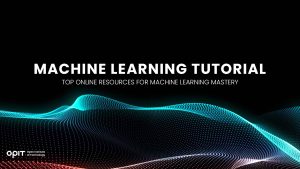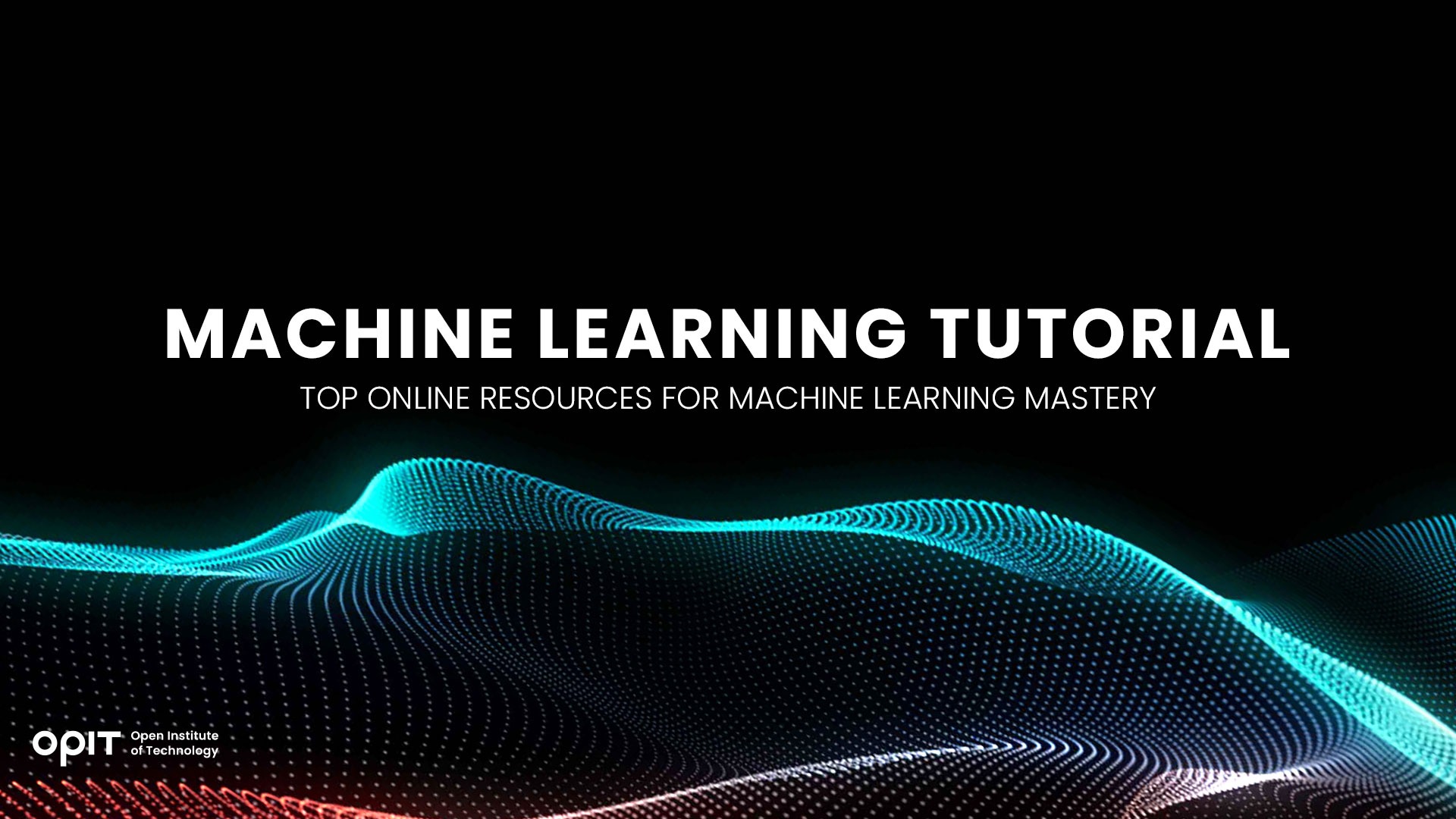

It can often feel like a computer has a “brain,” especially given modern machines’ abilities to run complex calculations and handle instructions. But all of those machines need people behind them to program algorithms and help them to learn based on explicit instructions. That’s where machine learning comes in.
This branch of artificial intelligence brings a machine’s “brain” closer to the real thing than ever before. It’s all about teaching the machine how to do more than simply execute, as machine learning is all about making a machine “think” (based on instructions and algorithms) so it can improve over time. That ability to “think” is crucial in modern business because it gives companies the ability to analyze patterns – both operational and consumer-based – enabling them to make smarter decisions.
But these businesses need people who understand how to create machine learning models. That’s where you come in. With the right machine learning tutorial under your belt, you set yourself up for a career in a field that has only just started to show glimpses of its potential.
The Best Machine Learning Tutorials
Finding the best online tutorial for machine learning isn’t easy given the sheer volume of options available. Analyzing each one based on what it teaches (and how useful it will be to your career) takes time, though you can save yourself that time by checking out the three tutorials highlighted here.
Tutorial 1 – Intro to Machine Learning (Kaggle)
As tempting as it may be to run before you can walk, you need an introduction to the basic concepts of machine learning prior to focusing on more practical applications. Enter Kaggle’s machine learning tutorial. This seven-lesson course takes about three hours of self-guided learning to complete and will leave you with a solid grounding in machine learning that you can take into more industry-focused courses.
The majority of the seven lessons – barring the first – is split into two parts. First comes a tutorial where you’ll learn about the concepts that the lesson introduces, with the second part being an exercise that tests your new skills. Along the way, you’ll learn the basics of how machine learning models work and why you need them to explore large datasets. Other lessons focus on building and validating a model, with the later lessons introducing more complex algorithms, such as random forests, and giving you a chance to test your skills in competitions.
Though this is a beginner-focused tutorial, you’ll need a solid understanding of Python before making a start. Without experience in this programming language, you’ll feel like you’re truly lost in a random forest before you ever get to learn what that term actually means. On the plus side, the tutorial has an active discussion community (which includes the course instructor Dan Becker) that can help you along and point you in the direction of other courses that supplement this one.
Tutorial 2 – Making Developers Awesome at Machine Learning (Machine Learning Mastery)
This machine learning tutorial is less a structured course and more a series of articles and step-by-step instructional lessons that take you from the foundations of machine learning to more advanced concepts. That method of breaking the course into multiple stages is ideal for students of all experience levels. Complete beginners can start with the “Foundations” level and work their way up while those with more experience can dip into specific subjects that give them trouble or will build on their existing skills.
The course is split into four sections – Foundations, Beginner, Intermediate, and Advanced. At the Foundations level, you’ll learn about the statistical concepts and models that underpin machine learning, giving you a solid basis to move into the Python programming taught in the Beginner section. Once you have a grasp of Python, the Intermediate section teaches you about deep learning and how to code machine learning algorithms. By the time you hit the Advanced stage, you’ll be working on complex subjects like computer vision and natural language processing.
With its less structured nature, this tutorial is great for people who want to dip in and out and those who need to hone in on a specific aspect of machine learning. It’s also a good choice for beginners because it covers practically everything you’ll need to know. Unfortunately, the lack of structure means you don’t get an official certification from the tutorial. Some students may also not like the “hub” nature of the tutorial, as it links you to tons of different web pages that can lead to confusion over time.
Tutorial 3 – Machine Learning Crash Course With TensorFlow APIs (Google)
If you already have a mathematical foundation (as well as some basic understanding of machine learning), Google’s tutorial helps you take your skills to the next level. You’ll need to understand algebra, statistics, and basic trigonometry, in addition to having some understanding of Python, to get started. But assuming you have all of that, this machine learning tutorial exposes you to real-world examples of the technology in action.
It’s a 25-lesson course that contains 30 exercises covering topics like model development and testing, data representation, and building neural networks. According to Google, it takes about 15 hours of self-guided study to complete, though your time may vary depending on how much you already know before you start the course.
The biggest advantage of this tutorial is the name attached to it. Google is a major player in the tech industry and the presence of its name on your CV instantly shows employers that you know your stuff. The course material is also delivered by lecturers who work at or for Google, allowing them to bring their real-world experiences into their lessons. On the downside, the tutorial’s prerequisites make it unsuitable for beginners, though Google does offer more basic courses (both in machine learning and Python) to help you build the required foundation.
Factors to Consider When Choosing a Machine Learning Tutorial
The three options presented above all make a solid case for the best online tutorial for machine learning, though each offers something different based on your current skill level. To make the best choice between the three (and any other tutorials you find) you should consider these factors before committing yourself.
Your Current Skill Level
Diving into neural networks before you even know how machine learning works is like trying to row upstream without a paddle. You’re going to get stuck in rough waters and the end result won’t be what you want it to be. Be honest with yourself about your current skill level to ensure you don’t start a tutorial that’s too difficult (or too simple) for your abilities.
Programming Languages
There’s no getting away from the fact that you’ll need to feel comfortable with programming before taking a machine learning tutorial. Specifically, you’re likely to need some knowledge of Python, though how much depends on the course you take. Other languages can help, at least in the sense of ensuring you’re familiar with programming, but you need to check the language the course uses before starting.
Specific Topics
Though the basic idea of building a machine “brain” is simple enough to understand, the machine learning waters run deep. There are tons of topics and potential specializations you could study, and not all are useful for your intended career path. Check what the course covers and ensure those topics align with what you hope to achieve once you’ve completed the tutorial.
Time Commitment
If a tutorial takes an hour or two to complete, you don’t really need to worry about how you’ll fit it around your other commitments. But if it takes you down a machine learning rabbit hole (i.e., the Machine Learning Mastery Course), you need to get serious with scheduling. Figure out how much time you can commit to your course per week and choose a tutorial that fits around your commitments.
The Cost
On the plus side, many machine learning tutorials are available free of charge. But if you’re looking for more official certification, or you want to take a more formal course, you’ll usually have to pay for the privilege. Weigh up the course’s cost against the benefit you get out of the backend.
Tips for Getting the Most Out of a Machine Learning Tutorial
Anybody can start a machine learning tutorial, but only the truly committed will complete and actually get the most out of the materials. Follow these tips to ensure you’re spending your time wisely on the tutorial you choose:
- Set clear goals from the outset that define what you want to achieve with the tutorial and where it’s supposed to lead you.
- Dedicate time to learning every week because regularity is the key to making the information you absorb stick in your mind.
- Engage with any communities related to your tutorial to learn from your peers and ask questions about the tutorial’s content.
- Apply what you learn to real-world problems, either via the course itself or by searching for examples of what you’ve learned being put into action.
- Update your knowledge and skills regularly with further tutorials because what you learn today may be out of date tomorrow.
Find the Best Online Tutorial for Machine Learning for You
There is no single “best” machine learning tutorial on the web because each approaches the subject differently. Some assume you have no knowledge at all and will start with basics before moving you into deeper subjects. Others require you to understand the computing concepts (mathematical and programmatical) that underpin machine learning before you can get started. Understand what the course offers, and what it needs from you, before you get started.
Regardless of your choice, getting started is the most important thing you can do. Once you’ve chosen a tutorial, commit yourself to it fully to take your first step (or potentially a giant leap) into a career that’s only going to grow as machine learning models become more common in business.
Related posts

Source:
- Agenda Digitale, published on November 25th, 2025
In recent years, the word ” sustainability ” has become a firm fixture in the corporate lexicon. However, simply “doing no harm” is no longer enough: the climate crisis , social inequalities , and the erosion of natural resources require a change of pace. This is where the net-positive paradigm comes in , a model that isn’t content to simply reduce negative impacts, but aims to generate more social and environmental value than is consumed.
This isn’t about philanthropy, nor is it about reputational makeovers: net-positive is a strategic approach that intertwines economics, technology, and corporate culture. Within this framework, digitalization becomes an essential lever, capable of enabling regenerative models through circular platforms and exponential technologies.
Blockchain, AI, and IoT: The Technological Triad of Regeneration
Blockchain, Artificial Intelligence, and the Internet of Things represent the technological triad that makes this paradigm shift possible. Each addresses a critical point in regeneration.
Blockchain guarantees the traceability of material flows and product life cycles, allowing a regenerated dress or a bottle collected at sea to tell their story in a transparent and verifiable way.
Artificial Intelligence optimizes recovery and redistribution chains, predicting supply and demand, reducing waste and improving the efficiency of circular processes .
Finally, IoT enables real-time monitoring, from sensors installed at recycling plants to sharing mobility platforms, returning granular data for quick, informed decisions.
These integrated technologies allow us to move beyond linear vision and enable systems in which value is continuously regenerated.
New business models: from product-as-a-service to incentive tokens
Digital regeneration is n’t limited to the technological dimension; it’s redefining business models. More and more companies are adopting product-as-a-service approaches , transforming goods into services: from technical clothing rentals to pay-per-use for industrial machinery. This approach reduces resource consumption and encourages modular design, designed for reuse.
At the same time, circular marketplaces create ecosystems where materials, components, and products find new life. No longer waste, but input for other production processes. The logic of scarcity is overturned in an economy of regenerated abundance.
To complete the picture, incentive tokens — digital tools that reward virtuous behavior, from collecting plastic from the sea to reusing used clothing — activate global communities and catalyze private capital for regeneration.
Measuring Impact: Integrated Metrics for Net-Positiveness
One of the main obstacles to the widespread adoption of net-positive models is the difficulty of measuring their impact. Traditional profit-focused accounting systems are not enough. They need to be combined with integrated metrics that combine ESG and ROI, such as impact-weighted accounting or innovative indicators like lifetime carbon savings.
In this way, companies can validate the scalability of their models and attract investors who are increasingly attentive to financial returns that go hand in hand with social and environmental returns.
Case studies: RePlanet Energy, RIFO, and Ogyre
Concrete examples demonstrate how the combination of circular platforms and exponential technologies can generate real value. RePlanet Energy has defined its Massive Transformative Purpose as “Enabling Regeneration” and is now providing sustainable energy to Nigerian schools and hospitals, thanks in part to transparent blockchain-based supply chains and the active contribution of employees. RIFO, a Tuscan circular fashion brand, regenerates textile waste into new clothing, supporting local artisans and promoting workplace inclusion, with transparency in the production process as a distinctive feature and driver of loyalty. Ogyre incentivizes fishermen to collect plastic during their fishing trips; the recovered material is digitally tracked and transformed into new products, while the global community participates through tokens and environmental compensation programs.
These cases demonstrate how regeneration and profitability are not contradictory, but can actually feed off each other, strengthening the competitiveness of businesses.
From Net Zero to Net Positive: The Role of Massive Transformative Purpose
The crucial point lies in the distinction between sustainability and regeneration. The former aims for net zero, that is, reducing the impact until it is completely neutralized. The latter goes further, aiming for a net positive, capable of giving back more than it consumes.
This shift in perspective requires a strong Massive Transformative Purpose: an inspiring and shared goal that guides strategic choices, preventing technology from becoming a sterile end. Without this level of intentionality, even the most advanced tools risk turning into gadgets with no impact.
Regenerating business also means regenerating skills to train a new generation of professionals capable not only of using technologies but also of directing them towards regenerative business models. From this perspective, training becomes the first step in a transformation that is simultaneously cultural, economic, and social.
The Regenerative Future: Technology, Skills, and Shared Value
Digital regeneration is not an abstract concept, but a concrete practice already being tested by companies in Europe and around the world. It’s an opportunity for businesses to redefine their role, moving from mere economic operators to drivers of net-positive value for society and the environment.
The combination of blockchain, AI, and IoT with circular product-as-a-service models, marketplaces, and incentive tokens can enable scalable and sustainable regenerative ecosystems. The future of business isn’t just measured in terms of margins, but in the ability to leave the world better than we found it.

Source:
- Raconteur, published on November 06th, 2025
Many firms have conducted successful Artificial Intelligence (AI) pilot projects, but scaling them across departments and workflows remains a challenge. Inference costs, data silos, talent gaps and poor alignment with business strategy are just some of the issues that leave organisations trapped in pilot purgatory. This inability to scale successful experiments means AI’s potential for improving enterprise efficiency, decision-making and innovation isn’t fully realised. So what’s the solution?
Although it’s not a magic bullet, an AI operating model is really the foundation for scaling pilot projects up to enterprise-wide deployments. Essentially it’s a structured framework that defines how the organisation develops, deploys and governs AI. By bringing together infrastructure, data, people, and governance in a flexible and secure way, it ensures that AI delivers value at scale while remaining ethical and compliant.
“A successful AI proof-of-concept is like building a single race car that can go fast,” says Professor Yu Xiong, chair of business analytics at the UK-based Surrey Business School. “An efficient AI technology operations model, however, is the entire system – the processes, tools, and team structures – for continuously manufacturing, maintaining, and safely operating an entire fleet of cars.”
But while the importance of this framework is clear, how should enterprises establish and embed it?
“It begins with a clear strategy that defines objectives, desired outcomes, and measurable success criteria, such as model performance, bias detection, and regulatory compliance metrics,” says Professor Azadeh Haratiannezhadi, co-founder of generative AI company Taktify and professor of generative AI in cybersecurity at OPIT – the Open Institute of Technology.
Platforms, tools and MLOps pipelines that enable models to be deployed, monitored and scaled in a safe and efficient way are also essential in practical terms.
“Tools and infrastructure must also be selected with transparency, cost, and governance in mind,” says Efrain Ruh, continental chief technology officer for Europe at Digitate. “Crucially, organisations need to continuously monitor the evolving AI landscape and adapt their models to new capabilities and market offerings.”
An open approach
The most effective AI operating models are also founded on openness, interoperability and modularity. Open source platforms and tools provide greater control over data, deployment environments and costs, for example. These characteristics can help enterprises to avoid vendor lock-in, successfully align AI to business culture and values, and embed it safely into cross-department workflows.
“Modularity and platformisation…avoids building isolated ‘silos’ for each project,” explains professor Xiong. “Instead, it provides a shared, reusable ‘AI platform’ that integrates toolchains for data preparation, model training, deployment, monitoring, and retraining. This drastically improves efficiency and reduces the cost of redundant work.”
A strong data strategy is equally vital for ensuring high-quality performance and reducing bias. Ideally, the AI operating model should be cloud and LLM agnostic too.
“This allows organisations to coordinate and orchestrate AI agents from various sources, whether that’s internal or 3rd party,” says Babak Hodjat, global chief technology officer of AI at Cognizant. “The interoperability also means businesses can adopt an agile iterative process for AI projects that is guided by measuring efficiency, productivity, and quality gains, while guaranteeing trust and safety are built into all elements of design and implementation.”
A robust AI operating model should feature clear objectives for compliance, security and data privacy, as well as accountability structures. Richard Corbridge, chief information officer of Segro, advises organisations to: “Start small with well-scoped pilots that solve real pain points, then bake in repeatable patterns, data contracts, test harnesses, explainability checks and rollback plans, so learning can be scaled without multiplying risk. If you don’t codify how models are approved, deployed, monitored and retired, you won’t get past pilot purgatory.”
Of course, technology alone can’t drive successful AI adoption at scale: the right skills and culture are also essential for embedding AI across the enterprise.
“Multidisciplinary teams that combine technical expertise in AI, security, and governance with deep business knowledge create a foundation for sustainable adoption,” says Professor Haratiannezhadi. “Ongoing training ensures staff acquire advanced AI skills while understanding associated risks and responsibilities.”
Ultimately, an AI operating model is the playbook that enables an enterprise to use AI responsibly and effectively at scale. By drawing together governance, technological infrastructure, cultural change and open collaboration, it supports the shift from isolated experiments to the kind of sustainable AI capability that can drive competitive advantage.
In other words, it’s the foundation for turning ambition into reality, and finally escaping pilot purgatory for good.
Have questions?
Visit our FAQ page or get in touch with us!
Write us at +39 335 576 0263
Get in touch at hello@opit.com
Talk to one of our Study Advisors
We are international
We can speak in:


